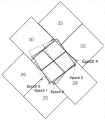|
|||||||||||||||||||
|
|
|||||||||||||||||||
GRAPES High-Level Science Products
at MAST
GRAPES is the Grism-ACS Program for Extragalactic Science project which was conducted in the Hubble Ultra-Deep Field (HUDF) during HST Cycle 12, over the period 2004 September to 2005 January. Sangeeta Malhotra is the PI for proposal 9793 for which 40 orbits were allocated. The project has a website with a list of the team members, the aims of the project and a list of papers resulting from analysis of the data.
 Slitless spectra in the Ultra-Deep Field were obtained
with the Advanced Camera for Surveys (ACS) with the Wide
Field Camera (WFC) over the field of 204x204 arcsec.
The figure to the left taken from
Pirzkal et al. 2004 ,
shows the relationship of the GRAPES field to the UDF and GOODS fields.
The G800L grism provides slitless spectra with a dispersion of
about 40 Å per pixel, but the achieved spectral resolution
depends on the size of the dispersing object. For a point
source of width 1.5 pixels, the resolution is 130 at 8000 Å.
The grism first order coverage is 5500-10500 Å with peak
sensitivity around 7500 Å.
Slitless spectra in the Ultra-Deep Field were obtained
with the Advanced Camera for Surveys (ACS) with the Wide
Field Camera (WFC) over the field of 204x204 arcsec.
The figure to the left taken from
Pirzkal et al. 2004 ,
shows the relationship of the GRAPES field to the UDF and GOODS fields.
The G800L grism provides slitless spectra with a dispersion of
about 40 Å per pixel, but the achieved spectral resolution
depends on the size of the dispersing object. For a point
source of width 1.5 pixels, the resolution is 130 at 8000 Å.
The grism first order coverage is 5500-10500 Å with peak
sensitivity around 7500 Å.
 Four epochs were observed in GRAPES at HST roll angles
(PA_V3) of 126, 134, 217 and 231 degrees. Exposures at a
roll angle of 117 degrees of the UDF field with the ACS
WFC and the G800L grism were also obtained in program
9352
(PI A. Riess) and were included in the data set to be
analysed. The total exposure time for the five epochs was
111462s. The strategy was to obtain a direct image in the
F606W filter followed by a series of G800L exposures at
the same roll angle but with small dithers. Thus at each
roll angle there are several sequences of a F606W image
and many G800L images. The earlier epoch (2002, October)
direct images at roll angle 117 degrees were taken with
the F850LP filter. The short direct images facilitated
the accurate alignment with the much deeper HUDF images
and catalogue.
Four epochs were observed in GRAPES at HST roll angles
(PA_V3) of 126, 134, 217 and 231 degrees. Exposures at a
roll angle of 117 degrees of the UDF field with the ACS
WFC and the G800L grism were also obtained in program
9352
(PI A. Riess) and were included in the data set to be
analysed. The total exposure time for the five epochs was
111462s. The strategy was to obtain a direct image in the
F606W filter followed by a series of G800L exposures at
the same roll angle but with small dithers. Thus at each
roll angle there are several sequences of a F606W image
and many G800L images. The earlier epoch (2002, October)
direct images at roll angle 117 degrees were taken with
the F850LP filter. The short direct images facilitated
the accurate alignment with the much deeper HUDF images
and catalogue.
The basic steps of data reduction of the ACS images were performed using the calacs pipeline. The spectra were extracted using the aXe package (http://www.stecf.org/software/aXe/) to produce 1D spectra. Full details of the reduction procedure can be found in the online data description or in Pirzkal et al. 2004.
This release constitutes 1400 1D extracted spectra from the GRAPES dataset which were selected to have i < 27.0 mag. A list of the GRAPES Data is ordered by the ID in the HUDF WFC Version 1.0 catalogue. The data may be downloaded individually from this page. They are also available via anonymous ftp from archive.stsci.edu in the directory /pub/hlsp/grapes.
A set of web pages with browsable spectra is also available. For each target in the HUDF with an HLSP GRAPES spectrum there is an entry in the web pages. Shown for each object are: the HUDF catalogue number, the i magnitude, the x,y position on the HUDF released image and the RA and Dec (J2000), a cut-out centred on the object taken from a colour composite of the HUDF images, a stack of the individual 2D spectra from the grism images, a plot of count rate v. wavelength for the available position angles, a plot of flux v. wavelength for the available position angles. In some cases not all the five position angles have grism data if one or more spectra fall outside the detector. The pages are sorted in order of increasing i magnitude.
An overview page listing Sequence number, HUDF ID number, Magnitude,
X-coord, Y-coord, RA, DEC is also provided as well as an index
ordered by the HUDF ID number.
|
|
|




 Follow Us
Follow Us